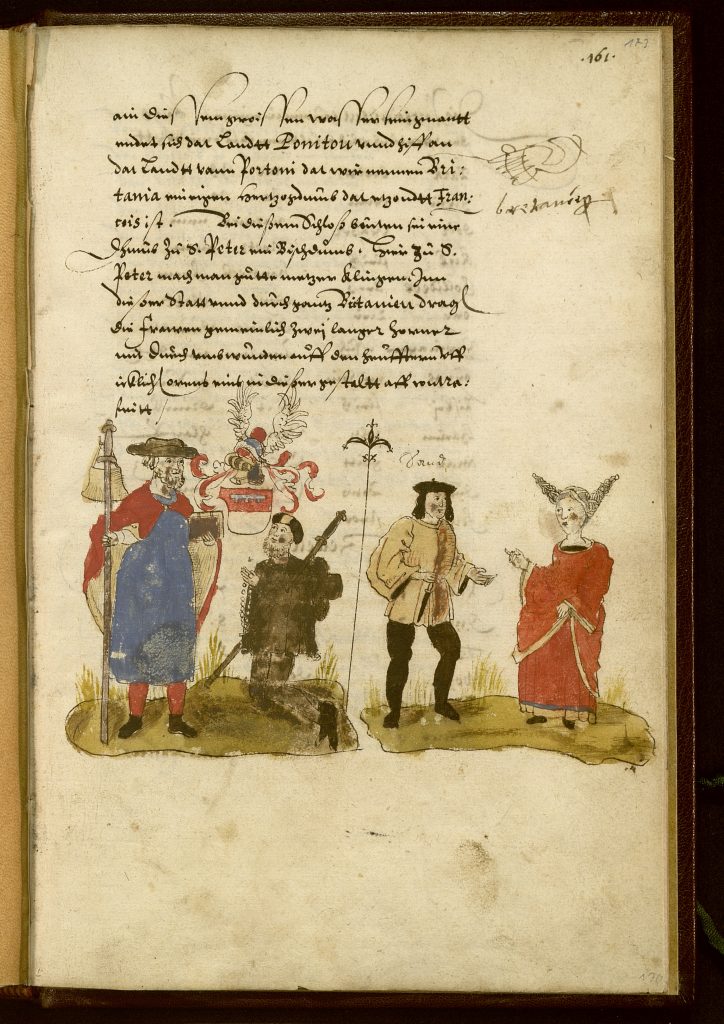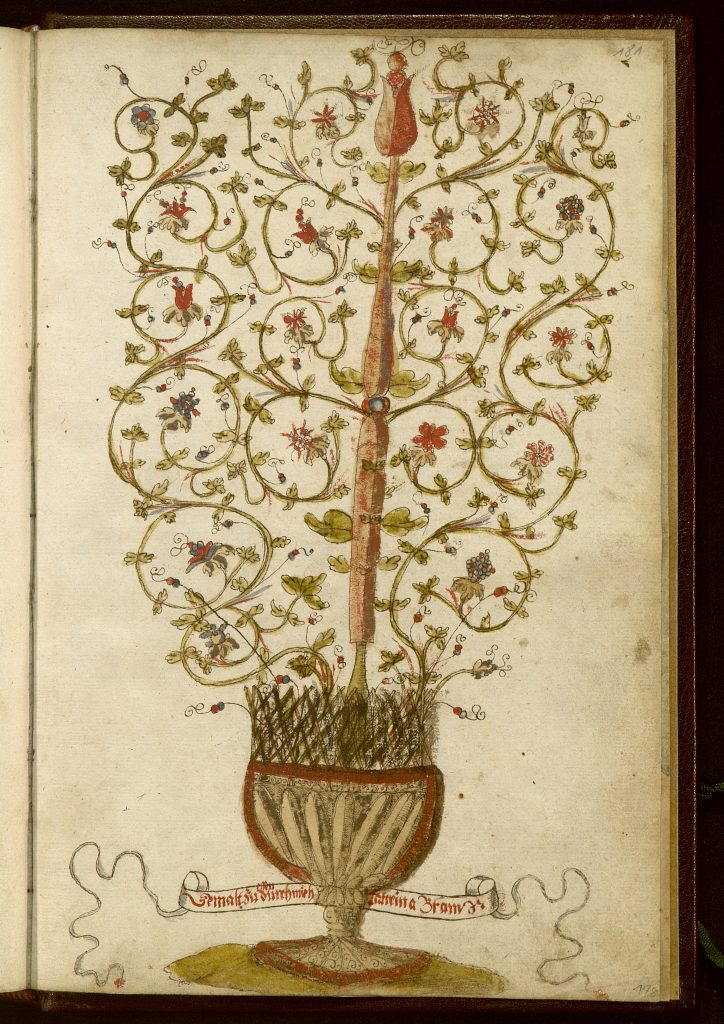Why this manuscript?
Although I myself grew up in the Lower Rhine region, my path to Arnold von Harff led me via the manuscript reading room in Oxford. Years ago, when I attended the course ‘Palaeography & History of the Book’ as part of my studies abroad, I looked at the travelogue of the knight Arnold von Harff, who came from my home region, in the Bodleian Library Oxford with the shelfmark MS. Bodl. 972, as my essay project.
Von Harff fascinated me at the time because he set out at a very young age on an incredibly long, arduous and not always harmless journey, retaining a never-ending appetite for new things and at the same time a certain independence in describing and evaluating what he experienced. While he is sceptical about the Catholic relics system, Arnold’s text reveals a pronounced curiosity, albeit not freed from prejudice, towards foreign living environments. Interested, he reports, among other things, about the Muslim faith and the reality of life of the Mamluks, and shows a special interest to describe female experience. It was a great source of (scholarly) inspiration for me to investigate these representations and trace the differentiated, vivid and open-minded image that Arnold von Harff draws from abroad as a ‘pilgrim, guide and poet’ for the Rhineland aristocratic society. Want to learn more about von Harff? Read the introductory post by Mary Boyle.
I was therefore very pleased when Henrike Lähnemann asked me to participate in the launch of the Taylor digital edition of MS. Bodl. 972 and if I would like to present the copy of the travelogue that is in the possession of the Universitäts- und Landesbibliothek (ULB) Bonn.
At this point, I would like to express my sincere thanks to Dr Michael Herkenhoff, who spontaneously supported the event very energetically and, together with his colleagues Daniela Lilova and Birgit Schaper, digitised the Bonn manuscript in no time at all and made it available online.

The Bonn manuscript S 447
The Universitäts- und Landesbibliothek (ULB) Bonn, Germany, owns a manuscript of the travel account of the knight Arnold von Harff (c. 1471–1505), which, according to the year added to the title page – 1591 –, was written about 40 years after MS. Bodl. 972 (with the siglum O). However, the date entered in MS. Bodl. 972 is likely a terminus post quem. The Bonn manuscript probably originated in the Rhineland and was initially in the possession of the University of Duisburg until it came to Bonn in 1818. By now the ULB Bonn has added the manuscript to their digital collections.
Similar to the Oxford copy, the paper manuscript with the shelf mark S 447 is bound in leather decorated with stamps and contains no text other than the travelogue of Arnold von Harff. The clasps are no longer preserved and have been replaced by cloth bands. It has three different page countings, the original counting is faulty as it counts fols. 90 to 99 twice. I follow the foliation inscribed in pencil at the top right of the recto pages, which also includes the flyleaves. Accordingly, the manuscript still contains 181 leaves, with fol. 16 missing but included in the count. Fol. 15 is blank.
The manuscript has similar dimensions (ca. 210 x 120 mm) as the Oxford copy, it is slightly larger and contains fewer lines (ca. 24) on average per page. As in MS. Bodl. 972, the text is written in one column; glossaries are in two and four columns. In contrast to MS. Bodl. 972, S 447 contains a title page with extensive information about the work; the scribe also names himself here: Geschrieben Dürh Petrüm Ganss vonn Rattingen. The script contains cursive elements and is later than in MS. Bodl. 972 which preserves the Bastarda as an older script from the late 14th and 15th century. Also the language of the manuscript, Lower Rhenish, is nearer to High German in comparison. The text is written in black ink and does not contain rubrication as found in MS. Bodl. 972. There is occasional underlining and numerous annotations by different hands. Several manicules, sometimes better sometimes worse drawn, should draw attention to important passages. One such pointer (with the caption bretanig = Breton) can also be seen on fol. 173r.
The manuscript contains 39 pen-and-wash drawings. The corpus and iconography of the illustrations remains surprisingly stable across the manuscript transmission. Insofar as pictures of other manuscripts are available for comparison, they always appear very similar, even though there can be some variety in the colours that are used, whether colours are used, or how detailed the images are. The Bonn manuscript uses a similar colour range as the Oxford copy, but it designs the colouring and certain details differently. Sometimes the illustrations overlap with the text, they have most likely been drawn after the text was written. The features of the faces are distinct, yet the colour wash filling is not too carefully done.
The illustration in MS. Bodl. 972, fol. 13v, which shows von Harff and St Peter, is not present in S 447 and may have been included on the missing leaf. On the other hand, fol. 169r in the Bonn manuscript shows an execution scene in Spain, which is missing in MS. Bodl. 972 and which was probably drawn on the missing folio (the ̔counterpart’ of fol. 140) that would have been expected between fols. 146v and 147r. In addition, the manuscript shows the family coat of arms in connection with the image of the pilgrim Arnold von Harff, which has not been added to some of the illustrations in MS. Bodl. 972. A peculiarity is that in various places (fol. 84r, fol. 125r and fol. 173r), S 447 compiles illustrations that appear on distinct pages in MS. Bodl. 972. This can also be seen, for example, on fol. 173r, which combines the illustrations which appear on fols. 148r and 152r in MS. Bodl. 972.
The last pen and ink drawing has no match in the tradition of the pilgrimʼs account. It is the only page-filling illustration and appears on fol. 181r, after the finis libri. This full-page illustration shows an opulent floral structure. In a banner below, a self-confident Rhenish female(!) illustrator proudly reveals her name and place of work: gemalt zu essen durch mich Katrein a Bram.

It is striking that just as MS. Bodl. 972, the Bonn manuscript has only one text, even though this is not unusual for the transmission of von Harff’s pilgrimage, just as the fact that before Groote’s edition in 1860, the text only existed in the form of manuscripts – even though printing was already available. These characteristics lead to the question of the recipients of the text. Arnold von Harff was a nobleman in the region of Jülich. Not only did he note down his travel experiences in honour of the duke of Jülich and his wife, but the text was also meant to secure fame and reputation. All the manuscripts of which the origin and provenance are known were initially produced and kept in the Rhineland and Westphalia. The manuscripts were spread among the nobility, which was strongly related to the family von Harff. It was probably perceived as an historical memento which strengthened familial solidarity. The texts have stayed in the libraries of noble families and for those that form part of a codex, the context of transmission is usually concerned with the nobility as well.
Digital copies, editions and translations:
Brall-Tuchel, Helmut; Reichert, Folker, Rom – Jerusalem – Santiago. Das Pilgertagebuch des Ritters Arnold von Harff (1496-89). Nach dem Text der Ausgabe von Eberhard von Groote übersetzt, kommentiert und eingeleitet, mit den Abbildungen der Handschrift 268 der Benediktinerabtei Maria Laach und zahlreichen anderen Abbildungen. 3., durchgesehene Auflage. (Köln/Weimar/Wien: Böhlau, 2009).
Bonn, Universitäts- und Landesbibliothek, S 447, URL: https://nbn-resolving.de/urn:nbn:de:hbz:5:1-292978 (5 May 2021).
Groote, E. von, ed. Die Pilgerfahrt des Ritters Arnold von Harff von Cöln durch Italien, Syrien, Aegypten, Arabien, Aethiopien, Nubien, Palästina, die Türkei, Frankreich und Spanien wie er sie in den Jahren 1496 bis 1499 vollendet, beschrieben und durch Zeichnungen erläutert hat. Nach den ältesten Handschriften und mit deren 47 Bildern in Holzschnitt. (Köln: J. M. Heberle, 1860).
Letts, Malcolm, ed., The Pilgrimage of Arnold von Harff, Knight, from Cologne. Through Italy, Syria, Egypt, Arabia, Ethiopia, Nubia, Palestine, Turkey, France and Spain, which he Accomplished in the years 1496-1499. Works issued by the Hakluyt Society, 2nd series, 94 (London: printed for the Hakluyt Society, 1946); electronic reproduction (Surrey: Ashgate, 2010).
Oxford, Bodleian Library, MS. Bodl. 972, URL: https://digital.bodleian.ox.ac.uk/objects/9eb27b9a-6d1b-40b3-97db-fda64e5a2ab9/surfaces/8c20c81a-5506-498e-8e7d-d2fbaf183123/ (5 May 2021).
Von Harff, Arnold, Reisebericht, Taylor Editions, edited by Agnes Hilger and Eva Neufeind, URL: https://editions.mml.ox.ac.uk/editions/harff/ (5 May 2021).
Selected Bibliography:
Kalliope-Verbund, URL: https://kalliope-verbund.info/DE-611-HS-2725532 (5 May 2021).
Handschriftencensus, URL: https://handschriftencensus.de/13210 (5 May 2021).
Honemann, Volker, ‘Zur Überlieferung der Reisebeschreibung Arnolds von Harff’, Zeitschrift für deutsches Altertum und deutsche Literatur cvii:ii (1978), pp. 165-178. [online]; URL: https://www.jstor.org/stable/20656273 (5 May 2021).
Honemann, Volker. “Arnold von Harff”. Verfasser-Datenbank. Berlin, New York: De Gruyter, 2012, URL: https://www.degruyter.com/document/database/VDBO/entry/vdbo.vlma.0224/html (5 May 2021).
Lahrkamp, Helmut, ‘Harff, Arnold von’, in Neue Deutsche Biographie 7, (1966), pp. 672-673. [online]; URL: http://www.deutsche-biographie.de/pnd104074787.html (5 May 2021).
Image Permissions
ULB Bonn, S 447: Creative Commons 1.0 International License.
About the Author:
Jasmin Leuchtenberg completed an MSt in Modern Languages at Wadham College in 2014. She is working at the University of Bonn (Germany), her research is about power and domination (Macht and Herrschaft) in Medieval German Literature.

1 thought on “The ‘Reisebericht’ of the knight Arnold von Harff in the ULB Bonn, Germany”